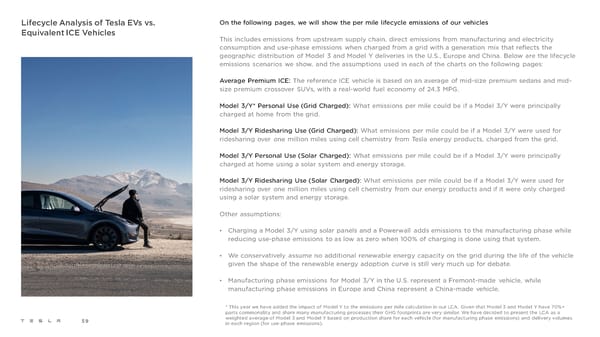Lifecycle Analysis of Tesla EVs vs. On the following pages, we will show the per mile lifecycle emissions of our vehicles Equivalent ICE Vehicles This includes emissions from upstream supply chain, direct emissions from manufacturing and electricity consumption and use-phase emissions when charged from a grid with a generation mix that reflects the geographic distribution of Model 3 and Model Y deliveries in the U.S., Europe and China. Below are the lifecycle emissions scenarios we show, and the assumptions used in each of the charts on the following pages: Average Premium ICE: The reference ICE vehicle is based on an average of mid-size premium sedans and mid- size premium crossover SUVs, with a real-world fuel economy of 24.3 MPG. Model 3/Y* Personal Use (Grid Charged): What emissions per mile could be if a Model 3/Y were principally charged at home from the grid. Model 3/Y Ridesharing Use (Grid Charged): What emissions per mile could be if a Model 3/Y were used for ridesharing over one million miles using cell chemistry from Tesla energy products, charged from the grid. Model 3/Y Personal Use (Solar Charged): What emissions per mile could be if a Model 3/Y were principally charged at home using a solar system and energy storage. Model 3/Y Ridesharing Use (Solar Charged): What emissions per mile could be if a Model 3/Y were used for ridesharing over one million miles using cell chemistry from our energy products and if it were only charged using a solar system and energy storage. Other assumptions: • Charging a Model 3/Y using solar panels and a Powerwall adds emissions to the manufacturing phase while reducing use-phase emissions to as low as zero when 100% of charging is done using that system. • We conservatively assume no additional renewable energy capacity on the grid during the life of the vehicle given the shape of the renewable energy adoption curve is still very much up for debate. • Manufacturing phase emissions for Model 3/Y in the U.S. represent a Fremont-made vehicle, while manufacturing phase emissions in Europe and China represent a China-made vehicle. * This year we have added the impact of Model Y to the emissions per mile calculation in our LCA. Given that Model 3 and Model Y have 70%+ parts commonality and share many manufacturing processes their GHG footprints are very similar. We have decided to present the LCA as a 59 weighted average of Model 3 and Model Y based on production share for each vehicle (for manufacturing phase emissions) and delivery volumes in each region (for use-phase emissions).
 Tesla 2021 Impact Report Page 58 Page 60
Tesla 2021 Impact Report Page 58 Page 60